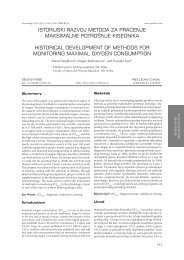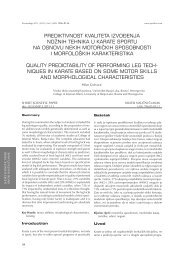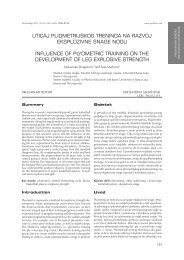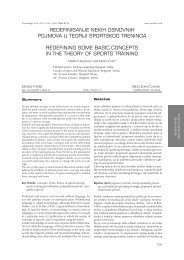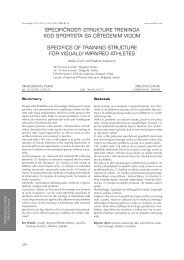metodologija izvoÄenja servisa u odbojci sa akcentom na servis iz ...
metodologija izvoÄenja servisa u odbojci sa akcentom na servis iz ...
metodologija izvoÄenja servisa u odbojci sa akcentom na servis iz ...
Create successful ePaper yourself
Turn your PDF publications into a flip-book with our unique Google optimized e-Paper software.
Vojvodi}, M., & ]ele{, N.: METHODOLOGY OF SERVING IN VOLLEYBALL... Proceedings 2011, 173–182IntroductionUvodPROFESSIONAL PAPERSTRUČNI ČLANAKService is a technical element of volleyball and representsthe beginning kickoff that is performed at the start of the setand after each mistake. It is a technical element whoseperformance begins at the struggle for points, and is deliveredby the player occupying the number one position behindthe baseline. It is one of the most important elements ofvolleyball and therefore requires special attention andplenty of training time at each training session. (Selinger2000). Tomic has recommended that service training shouldbe linked with other elements such as reception, organ<strong>iz</strong>ingof attacks, organ<strong>iz</strong>ing of specific roles for players and so on.It is not recommendable to practice service separate fromother elements. Each type of service has its advantages anddi<strong>sa</strong>dvantages (Tomic, 1976, p. 146). Service delivery ca<strong>na</strong>lso be very stressful, especially during crucial points. That’sbecause all the attention of players, coaches, audience andenvironment are focused on the player delivering the serve.Good service and proper practical implementation oftentend to be the decisive factor in the outcome of the match.In the tactics of serving it is extremely important to choosethe best and most efficient way of serving, and the right timeto apply it as well.According to the manner of delivery we can distinguishseveral types of services including: lower frontal service,overhead (upper) service, frontal jump service and sideservice, while in relation to the rotation of the ball, theservice can be with rotation and without rotation of theball.Today, in world-class volleyball, men’s as well as women’s,services that are exclusively applied are:• wall head-on service from the jump with ball rotation- Spike Service• wall head-on service from the jump without ball rotation- Float Service• upper butt out of service without ball rotation –FloaterWhen it comes to the speed of the ball during the serve,the highest possible speed is accomplished by setter serviceand it is approximately 120 km / h, or about 33 m / s. Duringthe well performed setter service, roughly the speed i<strong>sa</strong>bout 100 km / h or 28 m / s. Usually, the speed of the ballduring the service is approximately 15 m / s. It is establishedthat receiving players’ reaction time is 0.3 seconds, and thatduring the service with maximum ball speed, the ball travel<strong>sa</strong>bout 0.5 seconds from the moment it is struck to the timeof receipt. That means that this service is virtually uncatchable.During a well executed service, time travel of the ballis 0.7 seconds. This amount of time e<strong>na</strong>bles the receipt ofservice if the ball, in the moment of reception by the receivingplayer, doesn’t require any leg movement (Selinger 2000).During a normal ball speed service, the ball travels for aboutone second. This time is sufficient for the service receiver toposition himself well and to pass the ball to the setter. Ofcourse, this is not always the case, but a good effect can beachieved with this ball speed provided that the receivingplayers are not ready, and the server hits the right spot atthe right time.Service as anelement of the gameServis je tehnički eleme<strong>na</strong>t odbojka{ke igre i predstavljapočetni udarac koji se <strong>iz</strong>vodi <strong>na</strong> početku seta i poslije svakegre{ke, odnosno tehnički element čijim <strong>iz</strong>vođenjem počinjeborba za poen, a <strong>iz</strong>vodi ga igrač koji se <strong>na</strong>lazi u poziciji jedan<strong>iz</strong>a osnovne linije. On predstavlja jedan od <strong>na</strong>jbitnijih eleme<strong>na</strong>taodbojka{ke igre i zato mu treba posvetiti velikupažnju i dovoljno vreme<strong>na</strong> <strong>na</strong> svakom treningu. (Selinger2000). Tomić je preporučio da uvježbavanje <strong>servi<strong>sa</strong></strong> trebapovezivati <strong>sa</strong> drugim elementima kao {to su primanje <strong>servi<strong>sa</strong></strong>,organ<strong>iz</strong>ovanje <strong>na</strong>pada, organ<strong>iz</strong>ovanje pojedinih specifičnihuloga igrača i td. Nije dobro uvježbavati <strong>servis</strong> <strong>iz</strong>dvojen odostalih eleme<strong>na</strong>ta. Svaka vrsta <strong>servi<strong>sa</strong></strong> ima svoje prednosti inedostatke (Tomić, 1976, str. 146). Izvođenje <strong>servi<strong>sa</strong></strong> možeda bude i veoma stresno, pogotovo kod odlučujućih poe<strong>na</strong>.To je zbog toga {to je sva pažnja igrača, trenera, publike iokoline usredsređe<strong>na</strong> <strong>na</strong> igrača koji je <strong>na</strong> <strong>servis</strong>u. Dobro<strong>iz</strong>vođenje <strong>servi<strong>sa</strong></strong> i pravil<strong>na</strong> praktič<strong>na</strong> real<strong>iz</strong>acija, čestoz<strong>na</strong>ju da budu odlučujući faktor u ishodu utakmice. U takticiserviranja <strong>iz</strong>uzetno je važno <strong>iz</strong>abrati <strong>na</strong>jbolji, odnosno<strong>na</strong>jefikasniji <strong>na</strong>čin serviranja i u pravo ga vrijeme primjeniti.Prema <strong>na</strong>činu <strong>iz</strong>vođenja možemo razlikovati nekoliko vrsta<strong>servi<strong>sa</strong></strong> i to: donji čeoni <strong>servis</strong>, gornji čeoni <strong>servis</strong>, gornji čeoni<strong>servis</strong> <strong>iz</strong> skoka i bočni <strong>servis</strong>, a u odnosu <strong>na</strong> rotaciju lopte,<strong>servis</strong> u <strong>odbojci</strong> može biti <strong>sa</strong> rotacijom i bez rotacije lopte.Da<strong>na</strong>s se u vrhunskoj <strong>odbojci</strong> <strong>odbojci</strong>, kako mu{koj tako iženskoj, koriste isključivo ovi <strong>servis</strong>i:• gornji čeoni <strong>servis</strong> <strong>iz</strong> skoka <strong>sa</strong> rotacijom lopte - smeč<strong>servis</strong>• gornji čeoni <strong>servis</strong> <strong>iz</strong> skoka bez rotacije lopte - flot<strong>servis</strong>• gornji čeoni <strong>servis</strong> <strong>iz</strong> mjesta i bez rotacije lopte - lelujavi<strong>servis</strong>Kad je u pitanju brzi<strong>na</strong> kretanja lopte kod serviranja, <strong>na</strong>jvećamoguća brzi<strong>na</strong> lopte postiže se <strong>iz</strong>vođenjem smeč <strong>servi<strong>sa</strong></strong> io<strong>na</strong> približno <strong>iz</strong>nosi otprilike do 120 km/h , odnosno približno33 m/s. Prilikom odlično <strong>iz</strong>vedenog smeč <strong>servi<strong>sa</strong></strong>, brzi<strong>na</strong>lopte približno <strong>iz</strong>nosi oko 100 km/h ili 28 m/s. Najče{ća,odnosno uobičaje<strong>na</strong>, brzi<strong>na</strong> lopte prilikom serviranja približno<strong>iz</strong>nosi oko 15 m/s. Ustanovljeno je da vrijeme reagovanjaprimača <strong>iz</strong>nosi 0,3 sekunde, a da kod <strong>servi<strong>sa</strong></strong> <strong>iz</strong>vedenogmaksimalnom brzinom kretanja lopte, o<strong>na</strong> od momentaudarca do momenta prijema putuje oko 0,5 sekundi. Toz<strong>na</strong>či da je ovakav <strong>servis</strong> praktično neuhvatljiv. Prilikomodlično <strong>iz</strong>vedenog smeč <strong>servi<strong>sa</strong></strong> vrijeme leta lopte je 0,7sekundi, tako da ovo vrijeme omogućuje <strong>iz</strong>vođenje prijema<strong>servi<strong>sa</strong></strong> ukoliko lopta u momentu prijema od primača nezahtijeva pomjeranje nogama (Selinger 2000).Kod <strong>servi<strong>sa</strong></strong> <strong>iz</strong>vedenog uobičajenom brzinom lopte vrijemeleta lopte je oko jedne sekunde. Ovo vrijeme je dovoljnoda se primač <strong>servi<strong>sa</strong></strong> postavi <strong>na</strong> loptu i kvalitetno je dodad<strong>iz</strong>aču. Naravno, to nije uvijek tako, pa se dobar efekatpostiže i <strong>servis</strong>ima <strong>sa</strong> ovakvom brzinom lopte, pod uslovomda primači nisu dovoljno spremni, a server pogodi pravomjesto u pravom trenutku.Servis kaoelement igreThe service was created when volleyball was created, a<strong>sa</strong> way to throw the ball in play, that is to serve the ball to174Servis je <strong>na</strong>stao kada i odbojka, kao <strong>na</strong>čin da se loptaubaci u igru, odnosno da se lopta servira protivniku. U vrijeme<strong>na</strong>stajanja odbojke <strong>servis</strong> je predstavljao <strong>sa</strong>mo početak igre



